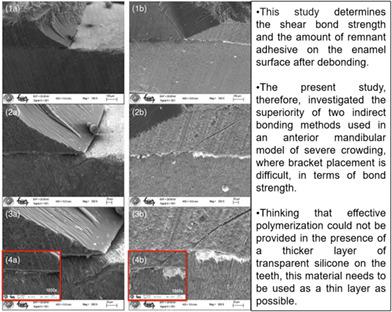当前位置:
X-MOL 学术
›
Microsc. Res. Tech.
›
论文详情
Our official English website, www.x-mol.net, welcomes your
feedback! (Note: you will need to create a separate account there.)
Evaluation of the effects of two different indirect bonding methods on strength of the brackets in mandibular model of severe anterior crowding
Microscopy Research and Technique ( IF 2.0 ) Pub Date : 2021-04-29 , DOI: 10.1002/jemt.23677 Betul Yuzbasioglu Ertugrul 1 , Özer Alkan 2
Microscopy Research and Technique ( IF 2.0 ) Pub Date : 2021-04-29 , DOI: 10.1002/jemt.23677 Betul Yuzbasioglu Ertugrul 1 , Özer Alkan 2
Affiliation

|
An indirect bonding method was developed to solve the problems likely to be encountered during proper positioning of the brackets. The aim of this study is to compare two different indirect bonding methods on the bond strength of the brackets. A 160 extracted human lower incisors were assigned into two groups. Transparent silicone material and bioplast material were used in transfer tray preparation in groups 1 and 2, respectively. Transbond XT adhesive system was used to bond brackets to teeth in both groups. A high intensity LED light source was used for 3 s for adhesive polymerization. Brackets were subjected to shear forces with universal test machine under 0.5 mm/min crosshead speed until failure. Adhesive Remnant Index was used to assess the amount of adhesive remnant on enamel surface after shear test under 10× magnification. Two subjects from both groups were evaluated for enamel surface characteristics with scanning electron microscope (SEM). Mean shear bond strengths were found to be 5.13 ± 1.8 MPa and 5.93 ± 2.19 MPa for silicone and bioplast groups, respectively. Bioplast group showed significantly greater shear bond strength than that of the silicone group. Maximum ARI score, assessed under ×10 magnification was 3 in both groups. A score of 3 was significantly more frequent in bioplast group. Differences were seen between the groups in terms of enamel surface characteristics under SEM evaluation. It was determined that bioplast material, which is considered to be the gold standard for the indirect bonding method, has greater shear bond strength than silicone material.
中文翻译:

两种不同间接粘接方式对严重前牙拥挤下颌模型托槽强度影响的评价
开发了一种间接粘合方法来解决在正确定位支架时可能遇到的问题。本研究的目的是比较两种不同的间接粘接方法对托槽粘接强度的影响。将 160 颗提取的人类下切牙分为两组。透明硅胶材料和生物塑料材料分别用于第 1 组和第 2 组的转移托盘制备。Transbond XT 粘合剂系统用于将托槽粘合到两组牙齿上。高强度 LED 光源用于粘合剂聚合 3 秒。支架用万能试验机在 0.5 毫米/分钟的十字头速度下承受剪切力,直至失效。残胶指数用于评估在 10 倍放大率下剪切试验后牙釉质表面的残胶量。使用扫描电子显微镜 (SEM) 评估两组中的两名受试者的牙釉质表面特征。发现有机硅和生物塑料组的平均剪切粘合强度分别为 5.13 ± 1.8 MPa 和 5.93 ± 2.19 MPa。Bioplast 组的剪切粘合强度明显高于有机硅组。在 10 倍放大倍数下评估的最大 ARI 评分在两组中均为 3。生物塑料组中 3 分的频率明显更高。在 SEM 评估下,在牙釉质表面特征方面观察到组之间的差异。已经确定,被认为是间接粘合方法的黄金标准的生物塑料材料具有比硅胶材料更高的剪切粘合强度。
更新日期:2021-05-27
中文翻译:

两种不同间接粘接方式对严重前牙拥挤下颌模型托槽强度影响的评价
开发了一种间接粘合方法来解决在正确定位支架时可能遇到的问题。本研究的目的是比较两种不同的间接粘接方法对托槽粘接强度的影响。将 160 颗提取的人类下切牙分为两组。透明硅胶材料和生物塑料材料分别用于第 1 组和第 2 组的转移托盘制备。Transbond XT 粘合剂系统用于将托槽粘合到两组牙齿上。高强度 LED 光源用于粘合剂聚合 3 秒。支架用万能试验机在 0.5 毫米/分钟的十字头速度下承受剪切力,直至失效。残胶指数用于评估在 10 倍放大率下剪切试验后牙釉质表面的残胶量。使用扫描电子显微镜 (SEM) 评估两组中的两名受试者的牙釉质表面特征。发现有机硅和生物塑料组的平均剪切粘合强度分别为 5.13 ± 1.8 MPa 和 5.93 ± 2.19 MPa。Bioplast 组的剪切粘合强度明显高于有机硅组。在 10 倍放大倍数下评估的最大 ARI 评分在两组中均为 3。生物塑料组中 3 分的频率明显更高。在 SEM 评估下,在牙釉质表面特征方面观察到组之间的差异。已经确定,被认为是间接粘合方法的黄金标准的生物塑料材料具有比硅胶材料更高的剪切粘合强度。











































 京公网安备 11010802027423号
京公网安备 11010802027423号